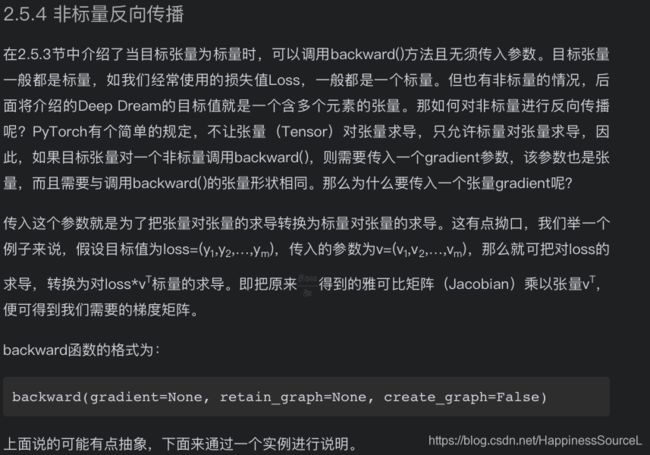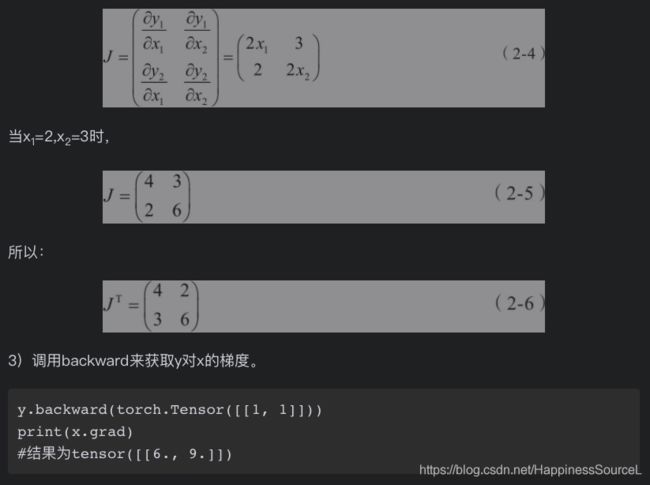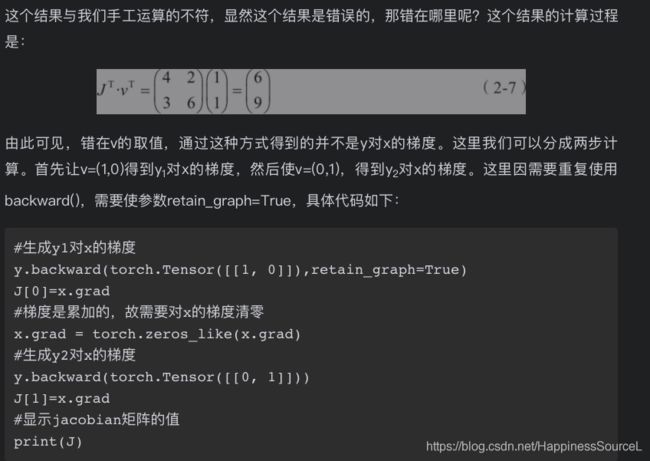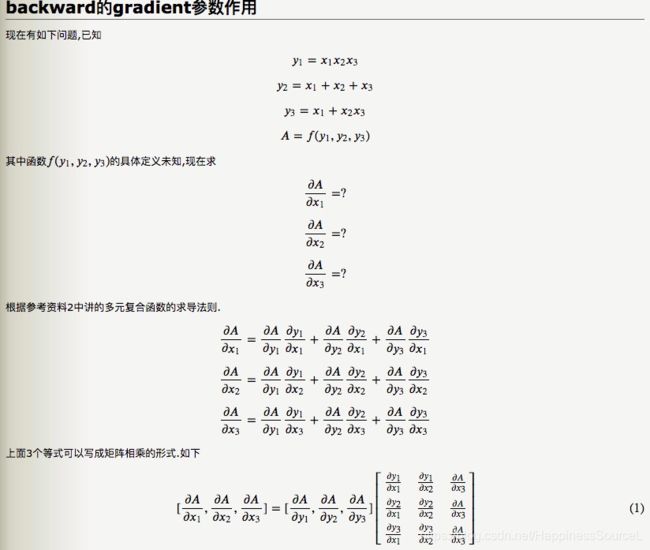pytorch中张量对张量的梯度求解:backward方法的gradient参数详解
一、问题起源:
阅读《python深度学习:基于pytorch》这本书的tensor 与Autograd一节时,看到2.5.4非标量反向传播
二、疑点在于:
backward(gradient=)这一参数没有理由的就选择了(1,1),之后调整为(1,0)和(0,1)便能正确求解,对该参数的设置原理,反向梯度求解的过程没有说清楚。
三、分析过程:
看完博客https://www.cnblogs.com/zhouyang209117/p/11023160.html
便确认gradient这一参数的设置应该是根据使用者的需求,比如说设置为(1,0)就正好求得y1对x的导数。
但是两者的求解过程不一致,书中=J的转置*V的转置,但是博客中假设的是V*J ,其实解释的原理都是一样的 ,就是希望设置V来分别在y的不同分量上求得对x的导数,然后组合向量,获得最终y对于x的导数。
虽然求解过程,但各偏导值是一致的。
书中x.grad = [[6,9]],但是博客中只有x1,x2,x3的梯度值,即便将代码改为对x求导,结果x.grad=None
x = torch.tensor([1,2,3],requires_grad=True, dtype=torch.float)
y.backward(torch.tensor([1, 1, 1], dtype=torch.float))
print(x.grad) # None 因为y赋值的时候是通过x1,x2,x3标量赋值的 ,与x无关。
如果改成以下代码:
y[0] = x[0]*x[1]*x[2]
y[1] = x[0]+x[1]+x[2]
y[2] = x[0]+x[1]*x[2]
y.backward(torch.tensor([1, 1, 1], dtype=torch.float))
print(x.grad) #tensor([8., 7., 5.])
则结果为tensor([8., 7., 5.]),梯度值shape为(1,3),与初始值x的shape保持一致
书中虽然计算过程为J的转置*V的转置,结果为列向量(6,9),但是输出值是[[6,9]],为行向量。 所以经过验证可知,实际的计算过程是gradient*Jacobian 。
另外check了官网的doc描述如下:其实对参数grad_tensors的描述并不是很清晰的,只提到了jacobian-voector product。如果有get到了这段话描述的具体计算过程的,或者与我理解的有不符合的 欢迎交流。就没有去check源代码了,因为两个测试代码段的计算结果和我以及上述博客的grad_tensors*jacobian是一致的。
书中原始代码块如下:
博客代码块如下,这个对A的假设是很好地,但是我们实际求的还是y对于x的偏导数,所以要构造A对y的偏导矩阵v与y对于x的偏导矩阵J 来做点积,这样实际求得的分量就是y对于x的偏导数:
# coding utf-8
import torch
x1 = torch.tensor(1, requires_grad=True, dtype=torch.float)
x2 = torch.tensor(2, requires_grad=True, dtype=torch.float)
x3 = torch.tensor(3, requires_grad=True, dtype=torch.float)
y = torch.randn(3)
y[0] = x1 * x2 * x3
y[1] = x1 + x2 + x3
y[2] = x1 + x2 * x3
x = torch.tensor([x1, x2, x3])
y.backward(torch.tensor([0.1, 0.2, 0.3], dtype=torch.float))
print(x1.grad)
print(x2.grad)
print(x3.grad)我的测试代码块如下:
# coding utf-8
import torch
#x1 = torch.tensor(1, requires_grad=True, dtype=torch.float)
#x2 = torch.tensor(2, requires_grad=True, dtype=torch.float)
#x3 = torch.tensor(3, requires_grad=True, dtype=torch.float)
x = torch.tensor([1,2,3],requires_grad=True, dtype=torch.float)
y = torch.randn(3)
#y[0] = x1 * x2 * x3
#y[1] = x1 + x2 + x3
#y[2] = x1 + x2 * x3
#x = torch.tensor([x1, x2, x3],requires_grad=True)
y[0] = x[0]*x[1]*x[2]
y[1] = x[0]+x[1]+x[2]
y[2] = x[0]+x[1]*x[2]
y.backward(torch.tensor([1, 1, 1], dtype=torch.float)) #只能对float类型求梯度
#print(x1.grad)
#print(x2.grad)
#print(x3.grad)
print(x.grad) #tensor([8., 7., 5.])
x = torch.tensor([[2,3]])
print(x.shape) #torch.Size([1, 2])








